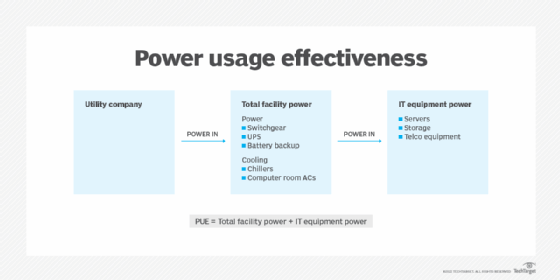What is PUE (power usage effectiveness)?
Power usage effectiveness (PUE) is a metric used to determine the energy efficiency of a data center. PUE is determined by dividing the total amount of power entering a data center by the power used to run the IT equipment within it. PUE is expressed as a ratio, with overall efficiency improving as the quotient decreases toward 1.0.
Data center infrastructure and the processing power within it require a lot of energy, and data centers that do not operate efficiently will use more electricity. Monitoring a metric like PUE is useful for benchmarking data center efficiency while keeping costs under control. Organizations and data center managers can use this metric once to measure their data center efficiency using its energy consumption and then again to measure the effect of any changes made to the data center facility. This helps reduce power consumption and energy costs.
PUE was created by members of The Green Grid, an industry group focused on data center energy efficiency. According to the "Uptime Institute Global Data Center Survey Results 2024" report, PUE and power consumption are among the top-tracked sustainability methods. A similar benchmarking standard recognized by The Green Grid is data center infrastructure efficiency, or DCiE.

How is PUE calculated?
The following equation calculates power usage effectiveness:
PUE = Total facility power/IT equipment energy
Total facility power is the amount of operational power the facility uses, which includes all data center hardware, power delivery components, cooling systems and lighting systems. IT equipment energy refers to the amount of energy that is used to power the storage and networking equipment at the site as well as control equipment, such as monitors and workstations.
As a value, PUE must be above 1.0 -- 1.3 to 3.0 is ideal -- which denotes efficient power delivery. Contributing factors can include minimal to no loss of electricity using the wiring infrastructure and equipment cooling achieved without the need for fans to move the air.
The DCiE metric is often compared with power usage effectiveness. It is the inverse of PUE, as it divides IT equipment energy usage by the total energy used by the data center. For example, a PUE of 1.0 equals a DCiE value of 100% -- or 100% energy efficiency -- and a PUE of 2.0 equates to a DCiE of 50%.
Calculate PUE using these steps:
- Measure energy use at the facility's utility meter. If the data center is in a mixed-use facility or office building, take a measurement only at the meter that powers the data center. If it is not on a separate utility meter, estimate the amount of power being consumed by the non-data center portion of the building and remove it from the equation. A better way of doing this, however, is by using data center infrastructure management (DCIM) application software. Instead of checking the utility meter to make an estimation, additional sensors are installed that collect real-time energy usage data for measuring PUE.
- Measure the IT equipment load after power conversion, switching and conditioning are completed. The most useful measurement point is at the power distribution units, which supply power to the computers and networking equipment. This measurement should represent the total power delivered to the server racks in the data center.
- Do the math. Once the measurements are collected, calculate PUE by dividing total facility power by equipment energy.
Benefits and limitations of PUE
The benefits of measuring power usage effectiveness include the following:
- PUE calculation can be repeated. The metric is meant to be used multiple times to gauge changes in data center efficiency.
- PUE value can gauge more efficient practices. The metric can help identify effective ways to reduce energy usage.
- DCIM software integration. DCIM software can automatically calculate PUE in real time, consolidating that data into reports.
- The PUE metric might be competitive. Organizations with good PUE ratios can use their score in marketing materials.
However, there are some limitations involved with data center PUE:
- Total facility power calculation is not always accurate. The accuracy of the total facility power calculation is a major factor affecting the measurement of PUE. If an organization has to estimate that number from a shared utility meter, then the resulting calculation is only an estimation.
- PUE does not capture consumption at the rack level. Energy that is consumed at the rack level is not part of the overall PUE calculation, which might make the PUE less accurate than desired.
- PUE is not meant as a marketing metric. Although organizations can use PUE in marketing, the metric is meant to be used as an improvement and assessment metric. Marketers should not rely heavily on PUE just because it might be a widely understood concept.
How can you lower PUE?
The following steps can help lower a data center's power usage effectiveness ratio closer to 1.0:
- Virtualize servers. Multiple virtual machines can run their own workloads on a single hardware server, which reduces energy consumption and frees up floor space.
- Improve cooling systems. Data centers require cooling systems to prevent overheating. However, refrigerant-based cooling systems use a lot of power. Improving these systems or reducing the data center's reliance on them can help lower PUE.
- Optimize cool air production. This can be done, for example, by using naturally cool outside air or heat exchangers, rather than relying on refrigerants.
- Replace inefficient hardware. The quality and performance of some hardware might degrade over time, so if servers or storage systems are not performing properly, they should be replaced.
- Use an energy-efficient uninterruptible power supply (UPS). Power distribution should be designed with a UPS to be more efficient. More efficient equipment and making power run a shorter distance help increase efficiency.
- Use energy-efficient lighting. Although lighting generally makes up a small portion of energy consumption, it is still an easy way to reduce power and heat production. Replacing fluorescent lighting with LEDs on motion sensors and lighting controls can help reduce operational power consumption and heat production.
Power usage effectiveness system manufacturers
PUE measurement technology is often provided by vendors who manufacture systems that examine and analyze overall data center infrastructure efficiency. The following are among the types of firms offering PUE measurement and expertise:
- Cooling system providers. Such firms provide systems and expertise for advanced cooling technologies that can reduce energy usage.
- Data center infrastructure management tools. DCIM systems handle the analysis and management of the many issues associated with a data center infrastructure.
- IT equipment manufacturers. Companies such as Dell and HPE offer energy-efficient servers and storage devices.
- Consulting Services. The Uptime Institute and The Green Grid provide consultancy services to improve PUE.
These vendors are among the companies that offer DCIM products:
- Device42.
- Hyperview.
- IBM Maximo.
- ManageEngine.
- Microsoft.
- Modius.
- Nlyte Software.
- Schneider Electric.
- Sunbird Software.
- Vertiv.
When selecting firms whose systems address PUE measurement, check each vendor's capabilities carefully to ensure they meet your infrastructure requirements.
Impact of AI on power usage effectiveness
As with most technologies in use today, AI greatly enhances the capabilities of data center infrastructure and energy management technologies. AI can enhance and optimize energy use by automating various repetitive tasks, such as power usage, cooling system performance monitoring and maintenance scheduling. Ironically, the use of AI applications can also increase costs related to greater energy demand, which can negatively affect the data center's carbon footprint. Ultimately, the use of AI for power management can help balance energy usage and environmental concerns.
The increasing carbon footprint of artificial intelligence is alarming. Discover how leaders can promote energy efficiency and sustainability for AI. Also, UPS systems typically require continuous maintenance over time. Learn more about UPS maintenance and how it helps safeguard data center power.






